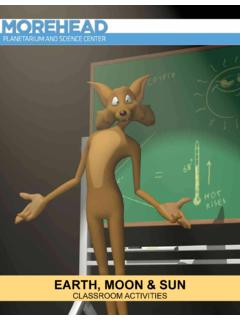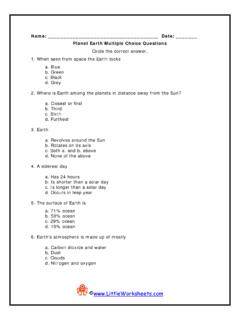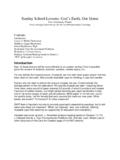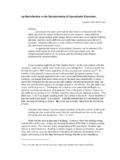Transcription of Grades K – 2 Education Guide - Mueller Planetarium
1 Grades K 2 Education Guide Written by Kim Small Illustrated by Audio Visual Imagineering The little Star That Could Grades K 2 Education Guide Table of Contents Standards Checklist*..3 Lessons Program Pre- and Post- Survey ..5 Lesson 1 The little Star That Could Lesson 2 The little Star That Could Venn Lesson 3 The little Star That Could Sun-Earth Connection Lesson 4 The little Star That Could Stellar Temperature and Lesson 5 Multiple Intelligence Mini-Lessons on the Solar Solar System Object Cards (large)..46 * The State Standards listed are standards that are included in 20 or more states core science standards according to Astronomy in the K-8 Core Curriculum: A Survey of State Requirements Nationwide written by Stacey Palen and AmyJo Proctor, Weber State University Copyright 2008, Audio Visual Imagineering, Inc.
2 2 The little Star That Could Grades K 2 Education Guide National Core Curriculum Standards in Science: The Sun has properties that can be observed and described. (K - 4 Standard) The Sun provides the light and heat necessary to maintain the temperature of the Earth. (K - 4 Standard) The AAAS Benchmarks for Literacy in Science: Stars are not all the same in brightness or color. (K 2 Benchmark) The Sun warms the land, air, and water. (K 2 Benchmark) Astronomy State Science Topics ( grade level varies based on state): Sun properties Planets/Solar System Inner/Outer planet characteristics Earth s position in the Solar System Gravitational attraction Asteroids Star properties Galaxies Copyright 2008, Audio Visual Imagineering, Inc. 3 The little Star That Could Grades K 2 Education Guide Pre-Program Lesson Plans: Pre-Survey Questionnaire Lesson 1 The little Star That Could Vocabulary With Assessment Lesson 2 The little Star That Could Venn Diagram With Assessment Lesson 3 The little Star That Could Sun-Earth Connection Storyboard and Assessment Lesson 4 The little Star That Could Stellar Temperature and Color (Use Assessment as a Post-Program Activity).
3 Post-Program Lesson Plans: Lesson 4 The little Star That Could Stellar Temperature and Color Assessment Lesson 5: Multiple Intelligence (Howard Gardner s Theory) Mini-Lessons and Assessments on the Solar System Post-Survey Questionnaire Copyright 2008, Audio Visual Imagineering, Inc. 4 The little Star That Could Grades K 2 Education Guide Pre- and Post- Survey Questionnaire Information The pre- and post- survey questionnaire may be used to help determine the overall effectiveness of this program and the supplemental educational tools provided. Students should be given the survey prior to any instruction or exposure to the program and/or the educational materials included. Student pre-survey scores should be recorded. Upon completion of the program and the utilization of the educational tools provided, the same group of students should be given the same survey.
4 The post-survey scores can be compared to the pre-survey scores to help determine the overall effectiveness of this program and the supplemental materials. For young students, the survey questions may be read allowed to them to assist in their reading and comprehension skills. Copyright 2008, Audio Visual Imagineering, Inc. 5 The little Star That Could Grades K 2 Education Guide Name _____Grade_____ The little Star That Could Survey 1) A large body that revolves around the Sun in the solar system is called a: a) Star b) Moon c) Planet d) Galaxy 2) Stars and planets are similar because: a) they are both round in shape b) they are both members of a solar system c) they can both come in different colors d) all of the above 3) The Sun is considered to be a) an average star b) a hotter than average star c) a cooler than average star d) a planet 4) What color are the hottest stars?
5 A) red b) blue c) yellow d) white 5) What color are the coolest stars? a) red b) blue c) yellow d) white Copyright 2008, Audio Visual Imagineering, Inc. 6 The little Star That Could Grades K 2 Education Guide 6) Which object provides the heat and light for the solar system? a) The Moon b) The Earth c) The Sun d) The stars 7) The dwarf planet that is located past the planet Neptune is called: a) Ceres b) Pluto c) Earth d) Jupiter 8) The only planet in the solar system that we know supports life.
6 A) Ceres b) Pluto c) Earth d) Jupiter 9) A natural body visible in the sky especially at night that gives off light is called a: a) planet b) moon c) dwarf planet d) star 10) Which planet comes next starting from the Sun out to Pluto: Mercury, Venus, Earth, Mars, Jupiter, _____. a) Saturn b) Uranus c) Neptune d) Pluto Copyright 2008, Audio Visual Imagineering, Inc. 7 The little Star That Could Grades K 2 Education Guide The little Star That Could Survey Answer Key 1) c planet 2) d all of the above 3) a an average star 4) b blue 5) a - red 6) c The Sun 7) b Pluto 8) c Earth 9) d star 10) a - Saturn Copyright 2008, Audio Visual Imagineering, Inc.
7 8 The little Star That Could Grades K 2 Education Guide Name _____ grade ____ The little Star That Could Vocabulary Objectives: As a group, students will define the The little Star That Could vocabulary words. Students will match each vocabulary word to its correct definition. Procedures: 1. Introduction - Write The little Star That Could vocabulary words on the board. 2. Explore prior knowledge - Ask each student to think about or write down the definition of each of the words. 3. Determine student confidence with prior knowledge - Ask the students to raise their hand if they think they know what each word means. Do this by starting with the first word and having the students simply indicate whether or not they think they know what the word means by raising their hand. 4. Create definitions - After determining approximately what percentage of students think they know the correct definition, call on multiple students with their hands raised and ask them what they think is the correct definition.
8 Write key points of each student s response on the board. 5. Class discussion and summary As a class, use the key points listed on the board to create a single definition for each word. (Students may need teacher guidance or input with some words) Show the answer key to the class and compare these definitions to the class definitions. Assessment: Students will independently match (by drawing a connecting line) each correct word to its definition. Modification/ Accommodations: For very young students (or students with low reading skills), create images for each definition. Use the image matching assessment sheet for these students. Copyright 2008, Audio Visual Imagineering, Inc. 9 The little Star That Could Grades K 2 Education Guide Name _____ grade ____ The little Star That Could Vocabulary Average Planet Star Sun Moon Gravity Copyright 2008, Audio Visual Imagineering, Inc.
9 10 The little Star That Could Grades K 2 Education Guide Lesson 1: The little Star That Could Vocabulary Answer Key (From the Merriam-Webster Dictionary) Average (adjective) being ordinary or usual Planet any of the large bodies that revolve around the Sun in the solar system Star a: a natural body visible in the sky especially at night that gives off light b: a ball-shaped gaseous celestial body (as the Sun) of great mass that shines by its own light Sun the star around which the planets revolve, from which they receive heat and light Moon the Earth's natural satellite that shines by reflecting light from the Sun (note: a satellite is a heavenly body orbiting another of larger size) Gravity a force of attraction between particles or bodies that occurs because of their mass, is stronger as mass is increased, and is weaker as the distance between the objects is increased Copyright 2008, Audio Visual Imagineering, Inc.
10 11 The little Star That Could Grades K 2 Education Guide Name _____ grade ____ The little Star That Could Vocabulary Assessment Directions: Match the word to its definition by drawing a line to the correct definition. Average a) the Earth's natural satellite that shines by reflecting light from the Sun Gravity b) the star around which the planets revolve, from which they receive heat and light Moon c) being ordinary or usual Planet d) a natural body visible in the sky especially at night that gives off light Star e) a force of attraction between particles or bodies that occurs because of their mass Sun f) any of the large bodies that revolve around the Sun in the solar system Copyright 2008, Audio Visual Imagineering, Inc. 12 The little Star That Could Grades K 2 Education Guide Lesson 1: The little Star That Could Vocabulary Assessment Answer Key Directions: Match the word to its definition by drawing a line to the correct definition.








